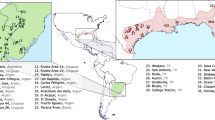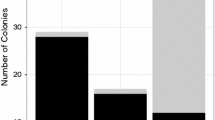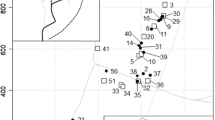Abstract
The little fire ant, Wasmannia auropunctata, is native to Central America, but has been introduced into many parts of the world. We examined the current distribution of W. auropunctata in Cameroon, tested for aggression between workers from different parts of the country, and examined the genotypes of workers, queens, and males to evaluate the mating system. We found W. auropunctata at 36 sites in three provinces (Centre, East, and South). We found W. auropunctata only in human-disturbed habitats. Its spread appears to be primarily human mediated. Aggressive behaviour was almost non-existent between workers from different sites, indicating that there is only one supercolony in Cameroon. Our genetic analysis found that only one male/female pair of clones was introduced into Cameroon, probably from Gabon. No new male clonal lineage was identified, whereas new sexually derived female clonal lineages were noted. Apart from the genotype of the founding queen, which was well distributed but generally not dominant, a new clonal queen genotype emerged and was both omnipresent and dominant at most sites. These results may be useful in the development of management strategies.



Similar content being viewed by others
References
Abbott K.L., Greaves S.N.J., Ritchie P.A. and Lester P.J. 2007. Behaviourally and genetically distinct populations of an invasive ant provide insight into invasion history and impacts on a tropical ant community. Biol. Invasions 9: 453–463
Armbrecht I. and Ulloa-Chacon P. 2003. The little fire ant Wasmannia auropunctata (Roger) (Hymenoptera: Formicidae) as a diversity indicator of ants in tropical dry forest fragments of Colombia. Environ. Entomol. 32: 542–547
Ayre G.L. 1977. Exotic ants in Winnipeg. Manit. Entomol. 11: 41–44
Beye M., Neumann P., Chapuisat M., Pamilo P. and Moritz R.F.A. 1998. Nestmate recognition and genetic relatedness of nests in the ant Formica pratensis. Behav. Ecol. Sociobiol. 43: 67–72
Buczkowski G. and Silverman J. 2006. Geographical variation in Argentine ant aggression behaviour mediated by environmentally derived nestmate recognition cues. Anim. Behav. 71: 327–335
Chapman R.E. and Bourke A.F.G. 2001. The influence of sociality on the conservation biology of social insects. Ecol. Lett. 4: 650–662
Deblauwe I. and Dekoninck W. 2007. Diversity and distribution of ground-dwelling ants in a lowland rainforest in southeast Cameroon. Insect. Soc. 54: 343–350
de Miré B. 1969. Une fourmi utilisée au Cameroun dans la lutte contre les mirides du cacaoyer. Wasmannia auropunctata Roger. Café Cacao Thé 13: 209–212
Deyrup M., Davis L. and Cover S. 2000. Exotic ants in Florida. Trans. Am. Entomol. Soc. 126: 293–326
Dimarco R.D., Farji-Brener A.G. and Premoli A.C. 2010. Dear enemy phenomenon in the leaf-cutting ant Acromyrmex lobicornis: behavioral and genetic evidence. Behav. Ecol. 21: 304–310
Foguieng S.A. 2007. Distribution spatiale et structure coloniale chez Solenopsis geminata (Formicidae; Myrmicinae) dans la ville de Douala. Mémoire de D.E.A. Université de Yaoundé, Cameroun. 43 pp
Foucaud J., Jourdan H., Le Breton J., Loiseau A., Konghouleux D. and Estoup A. 2006. Rare sexual reproduction events in the clonal reproduction system of introduced populations of the little fire ant. Evolution 60: 1646–1657
Foucaud J., Orivel J., Fournier D., Delabie J.H.C., Loiseau A., Le Breton J. and Cerdan P. 2009. Reproductive system, social organization, human disturbance and ecological dominance in native populations of the little fire ant, Wasmannia auropunctata. Mol. Ecol. 18: 5059–5073
Foucaud J., Orivel J., Loiseau A., Delabie J.H.C., Jourdan H., Konghouleux D., Vonshak M., Tindo M., Mercier J.-L., Fresneau D., Mikissa J.-B., McGlynn T., Mikheyev A.S., Oettler J. and Estoup A. 2010. Worldwide invasion by the little fire ant: routes of introduction and eco-evolutionary pathways. Evol. Appl. 3: 363–374
Fournier D., Foucaud J., Loiseau A., Cros-Arteil S., Jourdan H., Orivel J., Le Breton J., Chazeau J., Dejean A., Keller L. and Estoup A. 2005. Characterization and PCR multiplexing of polymorphic microsatellite loci for the invasive ant Wasmannia auropunctata. Mol. Ecol. Notes 5: 239–242
Heinze J., Foitzik S., Hippert A. and Hölldobler B. 1996. Apparent dear-enemy phenomenon and environment-based recognition cues in the ant Leptothorax nylanderi. Ethology 102: 510–522
Hoffman B.D., Andersen A.N. and Hill G.J. 1999. Impact of an introduced ant on native rainforest invertebrates: Pheidole megacephala in monsoomal Australia. Oecologia 120: 595–604
Hölldobler B. and Wilson E.O. 1990. The Ants. The Belknap Press of Haward University Press, Cambridge, Mass
Holway D.A. 1998. Factors governing rate of invasion: a natural experiment using argentine ants. Oecologia 115: 206–212
Holway D., Lach L., Suarez A.V., Tsutsui N.D. and Case T. 2002. The causes and consequences of ant invasions. Annu. Rev. Ecol. Syst. 33: 181–233
Klotz J.H., Mangold J.R., Vail K.M., Davis L.R. and Patterson R.S. 1995. A survey of the urban pest ants (Hymenoptera, Formicidae) of peninsular Florida. Fla. Entomol. 78: 109–118
Liang D. and Silverman J. 2000. “You are what you eat”: diet modifies cuticular hydrocarbons and nestmate recognition in the Argentine ant Linepithema humile. Naturwissenschaften 87: 412–416
Le Breton J., Chazeau J. and Jourdan H. 2003. Immediate impacts of invasion by Wasmannia auropunctata (Hymenoptera: Formicidae) on native litter ant fauna in a New Caledonian rainforest. Aust. Ecol. 28: 204–209
Lowe S., Browne M. and Boudjelas S. 2000. 100 of the world’s worst invasive alien species. Aliens 12: S1–S12
Majer J.D. and Delabie J.H.C. 1999. Impact of tree isolation on arboreal and ground ant communities in cleared pasture in the Atlantic rain forest region of Bahia, Brazil. Insect. Soc. 46: 281–290
Mikheyev, A.S., Bresson S. and Conant P. 2009. Single-queen introductions characterize regional and local invasions by the facultatively clonal little fire ant Wasmannia auropunctata. Mol. Ecol. 18: 2937–2944
Ndoutoume-Ndong A. and Mikissa B. 2007. Influence de la présence de la fourmi Wasmannia auropunctata (Roger 1863) (Hymenoptera: Formicidae) sur les autres espèces dans la réserve de la Lopé (centre du Gabon). Ann. Soc. Entomol.Fr. 43: 155–158
O’Dowd D.J., Green P.T. and Lake P.S. 2003. Invasional ‘meltdown’ on an oceanic island. Ecol. Lett. 6: 812–817
Okaue M., Yamamoto K., Touyam Y., Kameyama T., Terayama M., Sugiyama T., Murakami K. and Ito F. 2007. Distribution of the Argentine ant, Linepithema humile, along the Seto Inland Sea, western Japan: Result of surveys in 2003-2005. Entomol. Sc. 10: 337–342
Orivel J., Grangier J., Foucaud J., Le Breton J., Andrès F.-X., Jourdan H. and Delabie J.H.C. 2009. Ecologically heterogeneous populations of the invasive ant Wasmannia auropunctata within its native and introduced ranges. Ecol. Entomol. 34: 504–512
Passera L. 1994. Characteristics of tramp Species. In: Exotic Ants: Biology, Impact, and Control of Introduced Species (Williams D.F., Ed). Westview Press, Boulder, Colorado. pp 23–43
Rejmánek M. 1996. Species richness and resistance to invasion. In: Biodiversity and Ecosystem Processes in Tropical Forests (Orians G.H., Dirzo R. and Cushman J.H., Eds). Springer-Verlag, New York, pp 153–172
Santschi F. 1914. Formicidae de l’Afrique occidentale et australe du voyage de M. le Professeur F. Silvestri. Boll. Lab. Zool. gene. agr. (Portici, Italia). 8: 309–385
Suarez A.V., Holway D.A. and Case T.J. 2001. Predicting patterns of spread in biological invasions dominated by jump dispersal: insights from Argentine ants. Proc. Natl. Acad. Sci., USA 98: 1095–1100
Suarez A.V., Tsutsui N.D., Holway D.A. and Case T.J. 1999. Behavioral and genetic differentiation between native and introduced populations of the Argentine ant. Biol. Invas. 1: 43–53
Tsutsui N.D., Suarez A.V. and Grosberg R.K. 2003. Genetic diversity, asymmetrical aggression, and recognition in a widespread invasive species. Evolution 100: 1078–1080
Vander Meer R.K., Jaffe K. and Cedeno A. 1999. Applied Myrmecology: a World Perspective. Boulder, Colorado, Westview Press
Vinson S.B. 1997. Invasion of the red imported fire ant (Hymenoptera: Formicidae): spread, biology, and impact. Am. Entomol. 43: 23–39
Vonshak M., Dayan T., Foucaud J., Estoup A. and Hefetz A. 2009. The interplay between genetic and environmental effects on colony insularity in the clonal invasive little fire ant Wasmannia auropunctata. Behav. Ecol. Sociobiol. 63: 1667–1677
Walker L.K. 2006. Impact of the little fire ant, Wasmannia auropunctata, on native forest ants in Gabon. Biotropica 38: 666–673
Walsh P.D., Henschel P., Abernethy K.A., Tutin E.G., Telfer P. and Lahm S.A. 2004. Logging speeds little red fire ant invasion of Africa. Biotropica 36: 641–646
Wetterer J.K., Walsh P. and White L. 1999. Wasmannia auropunctata, une fourmi dangereuse pour la faune du Gabon. Canopée 14: 10–12
Wetterer J.K. and Porter S.D. 2003. The little fire ant, Wasmannia auropunctata: distribution, impact and control. Sociobiology 42: 1–41
Williams D.F. 1994. Exotic Ants: Biology, Impact, and Control of Introduced Species. Westview Press, Boulder, CO.
Acknowledgments
We would like to thank Barbara Gerber for her help in the laboratory, Andrea Dejean for proof-reading the manuscript and two anonymous referees for their helpful comments on the manuscript. Financial support for this study was provided by a grant from the French Ministry of Foreign Affairs (Project CORUS 2003-2006) and a grant from the French Ministry of Ecology and Sustainable Development–request for proposals ECOTROP to AE and JO.
Author information
Authors and Affiliations
Corresponding author
Rights and permissions
About this article
Cite this article
Tindo, M., Mbenoun Masse, P.S., Kenne, M. et al. Current distribution and population dynamics of the little fire ant supercolony in Cameroon. Insect. Soc. 59, 175–182 (2012). https://doi.org/10.1007/s00040-011-0202-x
Received:
Revised:
Accepted:
Published:
Issue Date:
DOI: https://doi.org/10.1007/s00040-011-0202-x




